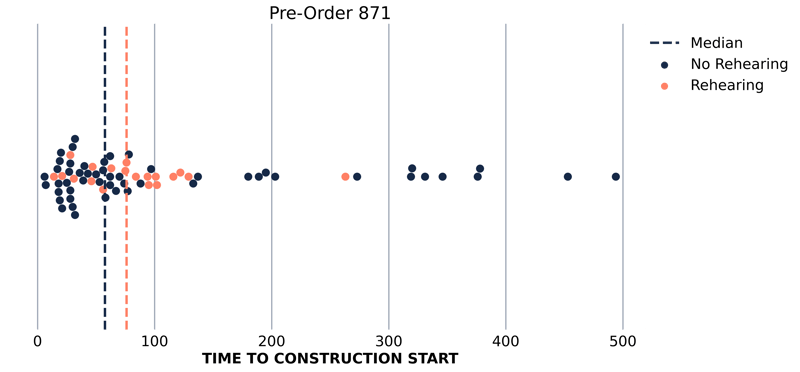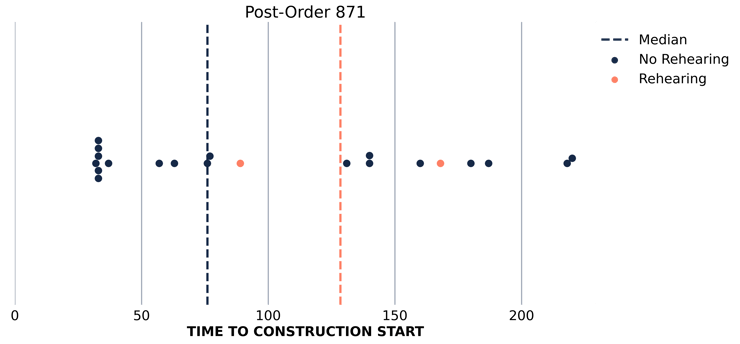How Much Time Has FERC Added to a Project Schedule by Delaying Construction?
Originally published for customers November 18, 2022
What’s the issue?
Back in June 2020, FERC issued an order that limited staff’s ability to authorize an applicant for a pipeline certificate to begin construction while the possibility of an appeal existed. Then in May 2021, FERC modified this order to clarify some issues that had been raised on rehearing of the original decision.
Why does it matter?
We have written repeatedly about how FERC is slowing down the review of applications, but this order slowing down the process after issuance of a certificate has typically flown under the radar.
What’s our view?
At the time the policy was first issued we noted that the new rule would appear to add anywhere from 30 to 60 days to the timeline of many projects and that it could be much longer. However, our review of over two years of data shows that the policy may only be adding about twenty days to the typical project timeline. The rule remains a solution looking for a problem and FERC could adopt a more limited solution to address the problem it feared existed.
Back in June 2020, FERC issued an order that limited staff’s ability to authorize an applicant for a pipeline certificate to begin construction while the possibility of an appeal existed. Then in May 2021, FERC modified this order to clarify some issues that had been raised on rehearing of the original decision. We have written repeatedly about how FERC is slowing down the review of applications, but this order slowing down the process after issuance of a certificate has typically flown under the radar.
At the time the policy was first issued we noted that the new rule would appear to add anywhere from 30 to 60 days to the timeline of many projects and that it could be much longer. However, our review of over two years of data shows that the policy may actually only be adding about twenty days to the typical project timeline. The rule remains a solution looking for a problem and FERC could adopt a more limited solution to address the problem it feared existed.
Protecting Landowners
The initial rule was very short and simply provided that FERC would not authorize construction for an approved project for the first 30 days following the issuance of the certificate and would extend that period if a request for rehearing was filed “until the Commission has acted upon the merits of that request.” The purported purpose of the rule was to protect landowners from activities being conducted on their land prior to FERC considering any issues that they might raise on rehearing, but the rule raised more questions than it answered. Therefore, in response to a number of rehearing requests about the exact contours of the rule, FERC issued a revised rule on May 4, 2021. Under the new rule, the time period during which FERC staff is prohibited from authorizing construction varies depending upon whether a rehearing request is filed and by whom.

Click here to download a full resolution PDF.
Data Shows Delays
We now have over two years of projects that have been approved since the issuance of the first version of the rule and we can try to tease out the impact it has had on a project getting the approval to start construction.

The visual above shows, for each project that was approved after the restoration of FERC’s quorum in 2017 through the date the new rule was issued, how long each project took to begin construction following the issuance of its certificate. As can be seen above, the time period without the rule varied greatly from as short as six days to almost 500 days. This timing is reflective of the fact that even before the rule a project often needed a lot of time to satisfy the pre-construction conditions in the certificate.
However, even with the confounding variable of other issues that can cause a delay in the commencement of construction, our data shows that since the issuance of the new rule, the median time period for the commencement of construction has grown by about two weeks for projects that had no rehearing requests filed and about two months for those that did have a rehearing request filed.

Data Shows Things Could Be Worse
Perhaps the most surprising aspect of the data before and after the issuance of the rule is that the percentage of projects that have been the subject of a rehearing request has actually gone down following the issuance of the rule. During the period prior to the rule, about 25% of projects were the subject of a rehearing request. But since the issuance of the rule, only 10% of projects that have commenced construction were the subject of a rehearing request. The lack of rehearing requests has allowed many projects to commence construction soon after the minimum thirty-day delay under the rule has expired. In fact, seven of the projects commenced construction within ten days after the minimum thirty-day delay period. Without the rule, it is very likely that those projects could have commenced construction even earlier.
Change in Rule Could Help Everyone
Now that we have two years worth of data, it may be time for FERC to revisit this rule and make a key change that would protect the interests of the parties the rule is designed to protect, while also allowing projects to move forward more quickly. As discussed above, every project is subject to a minimum thirty-day delay in construction that was not present prior to the adoption of the rule. Thus, many projects may not even be seeking construction authority before that time period expires. But as seen in the data for the period before adoption of the rule, many projects did get approval in that first thirty-day period.
Given the low percentage of projects that are actually the subject of rehearing requests, a simple change in the rule could allow the vast majority of projects to move forward as they did prior to the rule without being subjected to the minimum thirty-day delay. The rule could be modified to provide that a project could seek FERC authority to begin construction as soon as the pre-construction conditions in the certificate were met. FERC staff would need to wait five days to issue the construction authorization. If any party objected, the rule as currently drafted would be applied. But if no one objected within that five-day period, FERC staff would be free to authorize the commencement of construction. This would allow the 90% of projects that are not the subject of a rehearing request to move forward without regard to the rule, but ensure that projects for which parties intend to seek rehearing can be subjected to the rule by the simple filing of an objection to the request to commence construction. Such a change would return the process to almost as it was prior to issuance of the rule, but ensure that the rule is applied to those projects about which there is a legitimate concern.